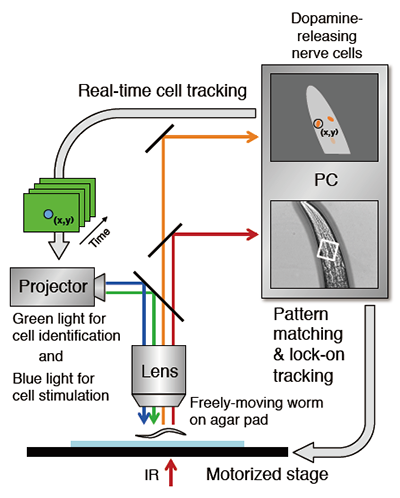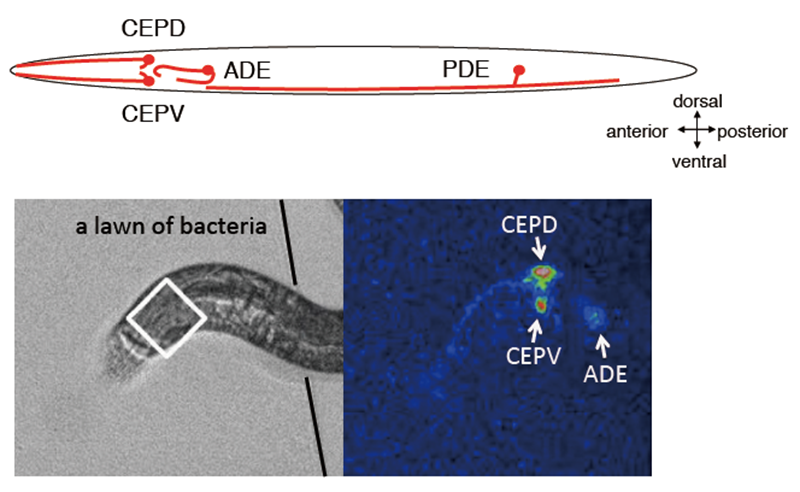Researchers from Osaka University and Tohoku University have developed a novel robot microscope system that automatically tracks a freely moving small animal and manipulates its brain activity with "projection mapping."
They've named the system OSaCaBeN or OSB. (Figure 1).
 |
|
Figure 1. Schematic drawing of the robot microscope system for optical manipulation of a nerve cell. (Adapted from Tanimoto et al., Scientific Reports) |
By using the robot-scope in their analysis of the nematode C. elegans - a roundworm widely used in the study of fundamental brain functions - the researchers revealed the functional diversification of nerve cells that release dopamine. Dopamine is a chemical that regulates movement, emotion and motivation in the brain of animals.
To understand how a brain works, it is necessary to measure activities of nerve cells in the brain and make a hypothesis of how the activity of a specific nerve cell is related to the function of the brain.
The hypothesis is then tested by artificially manipulating the activity of the nerve cell and observing its effect on the animal's behavior, the most prominent output of brain function.
Because of recent advances in genetic engineering techniques, activities of specific nerve cells can be optically measured and manipulated under a microscope. However, it is still challenging to understand the relationship between an animal's behavior and the activity of a specific nerve cell because of the complexity of an animal's brain.
The C. elegans is often used by neuroscientists because its very small brain consists of just 302 nerve cells. Still, it responds to various stimuli (and sometimes memorize them!) by using molecules that are very similar to the ones in other animals including humans. Moreover, because of the C. elegans' transparent body, nerve cell activities can be easily measured and manipulated by the above-mentioned optical techniques.
But analyzing the neural activities of moving worms is not easy. The worms move ~0.1mm per second, which is extremely difficult to follow because they pass through the field of vision of a microscope within a second. Prof. Koichi Hashimoto's research group solved the problem by developing a robot-scope that automatically tracks a worm on a stage with a state-of-the-art software technology called "machine-vision."
The robot-scope identifies a part of a worm's head (the white square in Figure 2 bottom left) from the entire image, and adjusts the position of the microscope stage to always keep the head at the center of the field of vision with a precision of ±0.001 mm.
 |
|
Figure 2. Dopamine-releasing nerve cells in worms and their activation. |
"Although such a process of image identification usually takes several hours, the robot scope does it 200 times per second," says Hashimoto. "This allows us to optically measure the continuous activities of multiple nerve cells in a worm's brain as it is moving."
Moreover, in a slightly different arrangement, the system also identifies and tracks one specific nerve cell (out of many) in a moving worm by another machine vision software, and manipulates its activity with the continuous illumination of a fine light beam. This is the only robot microscope system that performs both the optical measurement and manipulation of nerve cells with that level of precision.
With the robot-scope, Prof. Kotaro Kimura's group revealed functional diversification of dopamine-releasing nerve cells. In worms, dopamine has been known to be released from 4 pairs of nerve cells when they reach the food (a lawn of bacteria). Dopamine also modulates the movement of multiple parts of their body, signal sensations and learning.
However, how the food signal - the most important information for worms to survive - is transformed into activities of the dopamine-releasing nerve cells is not yet understood.
The researchers revealed that only the dorsal pair of dopamine-releasing neurons (CEPD) is substantially activated when food is reached. (Figure 2). Moreover, artificial activation of CEPD caused behavioral changes similar to that observed when the food is reached.
However, a structurally similar dorsal pair of dopamine-releasing nerve cells (CEPV) was not activated when it reached the food, and artificial activation of CEPV did not cause the behavioral changes similar to the activation of CEPD. It is likely that CEPV is activated in a different situation and plays a different role in behavioral modulation. Thus, the researchers revealed that even structurally symmetric dopamine-releasing neurons have asymmetric functions.
"We will analyze more of the relationships between brain and behavior using the robot microscope system on worms as well as zebrafish," says Kimura. "We would like to understand the basic principles of brain function through the analyses of these simple animals."
- Publication Details:
- Authors: Yuki Tanimoto, Ying Grace Zheng, Xianfeng Fei, Yukako Fujie, Koichi Hashimoto , Koutarou D. Kimura
Title: In actio optophysiological analyses reveal functional diversification of dopaminergic neurons in the nematode C. elegans
Journal: Scientific Reports
DOI: 10.1038/srep26297
Contact:
Koichi HashimotoDepartment of System Information Sciences,Graduate School of Information Sciences
Email: koichi
 m.tohoku.u.ac.jp
m.tohoku.u.ac.jpWebsite: http://www.ic.is.tohoku.ac.jp/en/koichi/

